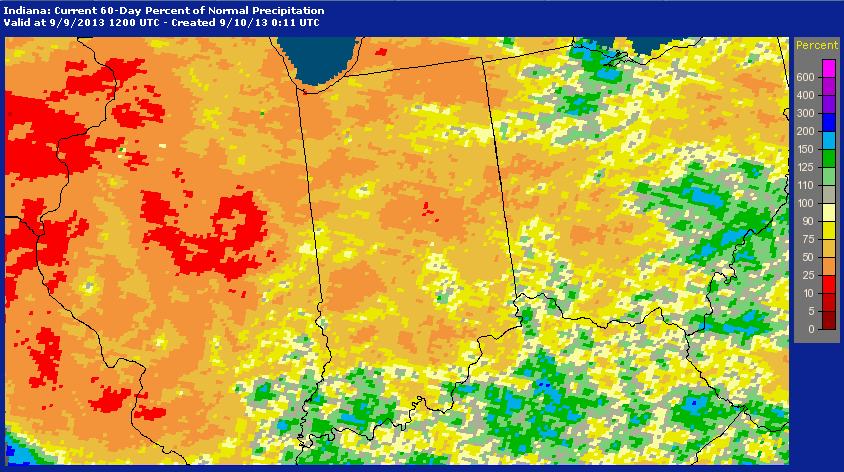10 Sep 2013
URL: http://www.kingcorn.org/news/articles.13/Frosting-0910.html
Corn Yield, Frosting, & Cake
R.L. (Bob) Nielsen
Agronomy Dept., Purdue Univ.
West Lafayette, IN 47907-2054
Email address: rnielsen
at purdue.edu
![]() lain and simple................. the "frosting is off the cake" for many corn fields around Indiana as dry (and often excessively hot) conditions continue through the end of this 2013 grain filling period. In fact, for some fields, the "cake" is disappearing too.
lain and simple................. the "frosting is off the cake" for many corn fields around Indiana as dry (and often excessively hot) conditions continue through the end of this 2013 grain filling period. In fact, for some fields, the "cake" is disappearing too.
Monday's USDA crop progress report estimated that 67% of Indiana's corn crop is at the dent stage of kernel development or beyond, which means that approximately 1/3 of the state's crop is still in the dough stage of development with 50% of its yield potential yet to be determined. Once corn reaches the dent stage, so-called "experts" are often heard confidently stating that there is no reason to worry about further crop stresses because "the crop is made". Actually, by the time a crop reaches full dent (every kernel dented), only about 60% of the crop has been "made" and there is still 40% of the potential yield "on the table" yet to be determined. Even by the time a crop has reached the so-called "half milkline" stage of kernel development (only about 2 weeks away from physiological maturity), sudden and complete death of the whole plant can result in yield losses as high as 12%.
Recognize that a crop of corn is not "made" until it has successfully reached physiological maturity. That is the final stage of kernel development determined by the presence of the thin, black layer at the tips of the kernels that prevents further movement of photosynthate into the grain.
NOTE: There is a common misconception that kernel black layer fails to develop in crops killed by drought, killing fall freezes, or other severe stresses. This is simply not true. Kernel black layer will always develop in corn grain. In fact, kernel black layer will develop sooner than expected on a calendar basis in severely stressed crops. When we talk about crops "shutting down" in response to severe stress, that means that the photosynthetic "machinery" is failing and the whole grain filling process is slowly coming to a grinding halt. Prove this to yourself by inspecting ears from droughty areas of a field with those from well-watered areas and you will see that kernel black layer develops sooner in the droughty areas. The same holds true for other severe stresses, such as extreme nitrogen deficiency.
The effects of inadequate rainfall throughout much of the grain filling period in Indiana (and elsewhere) have, at times, been amplified by the effects of excessively warm temperatures. Crops growing in soils with naturally low water-holding capacities or soils with significant levels of root-restricting soil compaction were the first to show the symptoms of drought stress (leaf rolling, lower leaf death, whole plant death). However, even crops growing in "good dirt" have been affected by the persistent lack of timely or adequate rainfall, coupled with excessive heat, in recent days and weeks.
Certainly, not every field of corn is in "dire straits" at the moment. Certainly, there will be fields of corn that yield well or possibly better than they ever have in the past. Just as certainly, there will be fields with significant yield losses due to excessively dry soils and excessively hot temperatures during the past 30 days or so.

Fig. 1. Percent of normal precipitation as of 9 Sep 2013 for the previous 60 days. Image source: NWS-AHPS.
It is imperative that growers recognize that such severe photosynthetic stress during the grain filling period often results in plants "cannibalizing" themselves to meet the carbohydrate "demands" of the developing grain. This is especially true when pollination and initial kernel set have been good; resulting in ears with high kernel numbers. Stored carbohydrate reserves in the lower stalk and leaf tissues are often remobilized to the developing ears in response to photosynthetic stress. Two consequences of such carbohydrate remobilization are the 1) physical weakening of the lower stalk and 2) increased susceptibility to root and stalk rots.
Such cannibalized or diseased plants are naturally more apt to break over or lodge in response to strong winds, potentially turning grain harvest into a frustrating and challenging operation. Growers ought to be walking drought-stressed fields during the next several weeks to assess the presence and severity of weakened stalks (or actual stalk breakage); then work towards prioritizing the weakest fields for early harvest to minimize the risk of significant mechanical harvest yield losses.
Related reading
Nielsen, RL (Bob). 2013. Grain Fill Stages in Corn. Corny News Network, Purdue Extension. [online] http://www.kingcorn.org/news/timeless/GrainFill.html [URL accessed Sep 2013].
Nielsen, RL (Bob). 2013. Stress During Grain Fill: A Harbinger of Stalk Health Problems. Corny News Network, Purdue Extension. [online] http://www.kingcorn.org/news/timeless/StalkHealth.html [URL accessed Sep 2013].

